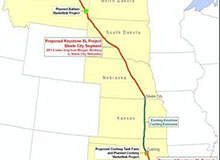
Click here or on the image above to be taken to Keystone XL pipeline infographic – a crash course.
Keystone XL Pipeline is a new 1,897km-long crude oil pipeline being developed by TransCanada. The cross-border pipeline will run from Hardisty in Canada to Steele City, Nebraska, and Texas in the US.
The pipeline has a capacity to deliver 830,000bpd of crude oil and is expected to reduce greenhouse gas emissions by 19 million metric tonnes.
TransCanada is currently undertaking the permit procedure for the project, which will be completed by 2018. Construction for the Keystone XL pipeline project is expected to start in 2019.
The project will help the US reduce its natural gas imports from the Middle East and Venezuela. It is expected to create approximately 20,000 jobs during the construction and operation phases.
Developing the cross-border crude oil pipeline
The Keystone XL pipeline was proposed by TransCanada in June 2008. The Presidential Permit application for the project was submitted to the US Department of State (DoS) in September 2008.
The project received approval from the National Energy Board (NEB) of Canada in March 2010. The Final Environmental Impact Statement (FEIS) for the project was issued in August 2011.
However, the Presidential Permit application was again denied by the DoS in January 2012 as the pipeline route was exploiting the Sand Hills region in Nebraska. TransCanada resubmitted the application in May 2012 by proposing a new route avoiding the Sand Hills of Nebraska.
DoS evaluated the pipeline’s new proposed route and published the final Social and Environmental Impact study report in January 2014. The project failed to receive the Presidential Permit from the US Government and was put on hold.
TransCanada applied for Keystone XL pipeline route approval in Nebraska in February 2017, which was approved by Nebraska Public Service Commission (NPSC) in November 2017. TransCanada finally received Presidential Permit in March 2017 to begin the project.
Route of Keystone XL through North America
Keystone XL pipeline aims to supply crude oil from the Western Canadian Sedimentary Basin (WCSB) in Canada and the Bakken Shale Formation in the US to existing Keystone Pipeline in Steele City, Nebraska, and Texas.
The Canadian portion of the Keystone XL Pipeline will include a 529km-long pipeline segment. The pipeline will originate at the Hardisty terminal and continue through Alberta, towards the south, before entering in the Canadian-US border at Monchy in Saskatchewan.
It will enter the US at Morgan on Montana’s border and pass through South Dakota, as well as Nebraska, where it will be connected to the existing Keystone Pipeline at Steele City.
Construction and infrastructure of the Canadian -US pipeline
Keystone XL pipeline construction will involve burial of 36in diameter segments with a minimum depth of cover of 2m. The pipeline will have a permanent right-of-way with a width of 15m. The operating pressure for Keystone XL pipeline will be 1,308psig (pound force per inch).
An 18m space will be left as a temporary workspace. Additional temporary work space will be created to ensure smooth pipeline construction at road and rail crossings, existing pipeline corridors, river crossings and other major locations.
Inspection of all welds will be carried out using non-destructive examination equipment. Piping used in the project will be covered with a corrosion-resistant protective coating. The pipeline sections will be pressure-tested with water before operations start. The project will implement environmental protection plans to re-establish the vegetation on the passage once construction is complete.
There will be above-ground facilities to support the pipeline operation. The above ground infrastructure will include 30 pump stations to ensure the free flow of crude oil through the pipeline and 112 mainline valves. The project will also involve construction of an alternative terminal and delivery points. Tank farms covering 74 acres will be constructed at Cushing and Oklahoma delivery points.
Keystone XL Pipeline operations
Keystone XL will have an initial capacity of 700,000bpd with a further capacity to transport 830,000bpd. The pipeline will increase the total capacity of Keystone Pipeline to 1.3Mbpd.
The pipeline will be continuously monitored using supervisory control and data acquisition (SCADA) and leak detection systems. Pumps and valves will be remotely controlled from a computerised control centre, manned 24 hours a day. The pipeline will be equipped with 21,000 data transmitters for observing the pressure and oil flow.
Related content
Keystone XL Pipeline – the energy issue that has split America
The debate over whether the US President should approve TransCanada’s proposed 835 mile Keystone XL Pipeline has divided the nation.
Keystone XL Pipeline infographic – a crash course
TransCanada’s proposed 835 mile Keystone XL Pipeline has divided a nation, but how do the facts stack up?





